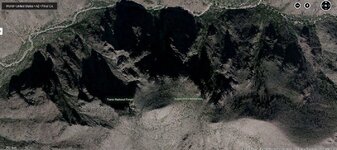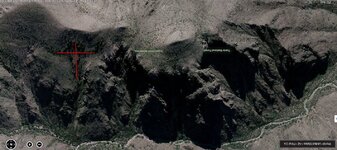eagle_scout
Tenderfoot

this is a screen shot of Hog Canyon as seen on Bing Maps. If you look in the lower right you will see a feature, on the shoulder of the mountain, that looks similar to a crucifix. Old Spanish mines are easy to spot once you know what to look for. Several years ago, I was searching for the Lost Spanish Mine of Culebra Peak, in Southern Colorado. I found it, after a lot of footwork and searching. but the first clue came to me by a prayer answered. thats right. i was praying to my Lord and Savior Jesus Christ. I was asking for forgiveness, and praying for help with this problem I have, Lust and greed for Gold and Treasure!. he answered my prayer, he said, " search for me and you will find the treasure". that's when a light came on! Crosses started to pop up everywhere! How many mountains in the southwest are known for the big cross on their shoulder? lots of them. Holy Cross Mountain for one. Most of these crosses were the result of Spanish mining. their technique was to dig a vertical trench, following the ore vein up the mountain, and a cross trench cut horizontally, where they lived or used beasts of burden to haul their gear up and down the vertical shaft. Those Spanish Conquistadors had a passion for gold, but had a greater passion for Jesus. they carved crosses everywhere. Especially over the top of Indian art. they thought the Native Indians were pagans.
it was the crosses that I found, while searching on foot, that lead me to the location of the mine on Culebra peak.
the mine pictured here, on Hog ridge, between hog canyon and heiroglyph canyon, is in my opinion, THE LOST DUTCHMAN MINE. Also look carefully at the shadow cast by by the natural arch, it is a heart with a triangle of light. this is also a clue for the Priest Map Stone which I will discuss later. Remember: the priest has a cross on his shoulder! just like this mountain.








 ...and when it's all loose rock like that, it's steep.
...and when it's all loose rock like that, it's steep.
